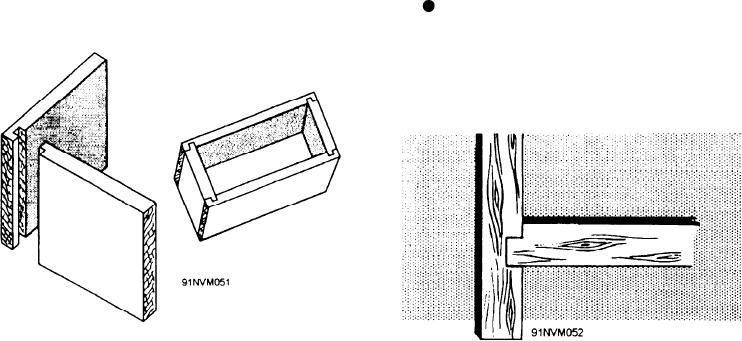bare-faced tongue. The dado and rabbet joint (fig.
same. Change the height of the saw if the depth of
3-25) is another joint often used in making boxes,
the cheek is different.
drawers, and cabinets.
By using the dado head, you can cut most
The housed lock-joint (fig. 3-26) is a type of
rabbets in a single cut. First, build up a dado head
dado and rabbet joint. Note that the rabbeted piece
equal in thickness to the desired width of the cheek.
is reversed. The dadoed piece extends beyond the
Next, set the head to protrude above the table a
rabbeted piece. This joint is used extensively in the
distance equal to the desired depth of the shoulder.
pattern shop for manufacturing special wooden
Clamp a l-inch board to the fence to serve as a
foundry flasks. The dadoed piece extends to form
guide for the piece. Set the fence so the edge of
handles for the flask.
the board barely contacts the right side of the dado
head. Set the piece against the miter gauge that is
Dovetail Joints
set at 90 to the saw blade. Now hold the edge or
end to be rabbeted against the l-inch board and
The dovetail joint (refer to fig. 3-17) is the
make the cut.
strongest of all the woodworking joints. However,
its construction requires a lot of work; therefore,
On jointers, a rabbeting strip on the outboard
you will use dovetail joints only when working on
edge of the outfeed table depresses for rabbeting.
finer grades of furniture and cabinet work.
The strip is outboard of the end of the cutterhead.
To rabbet on a jointer, you depress the infeed table
A joint containing only a single pin is a single
and the rabbeting strip the depth of the rabbet
dovetail joint. A joint containing two or more pins
below the outfeed table. Set the fence the width of
is a multiple dovetail joint. A joint in which the
the rabbet away from the outboard end of the
pins pass all the way through the tail member is a
cutterhead. The unrabbeted part feeds onto the
through dovetail joint. A joint in which they pass
rabbeting strip when the piece feeds through.
only part way through is a blind dovetail.
The simplest dovetail joints is the half-lap
used in woodworking. The well-known
dovetail joint (fig. 3-27). This joint is first laid out
tongue-and-groove joint is actually a combination of
and cut like an ordinary end half lap. The end of
the groove and the rabbet. The tongued member is
the lapping member is laid out for shaping into a
simply a member rabbeted on both faces. In some
dove tail as follows:
types of panel work, the tongue is made by
rabbeting only one face. A tongue of this kind is a
Set the T-bevel to 10. This is the correct
angle between the vertical axis and the sides of a
dovetail pin or tail. You can set the bevel with a
protractor or with the protractor head on the
Figure 3-25.--Dado and rabbet joint.
Figure 3-26.--Housed lock-joint.
3-22






